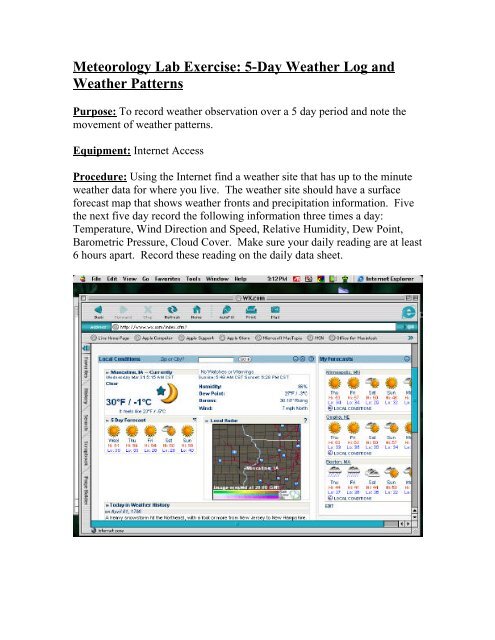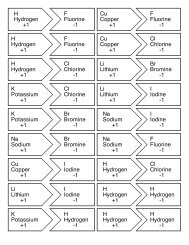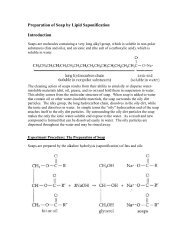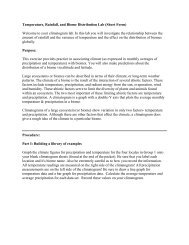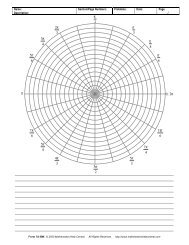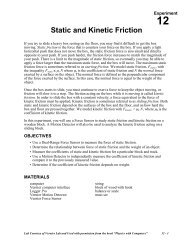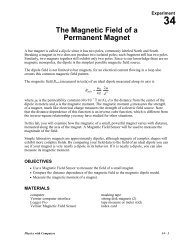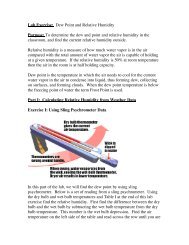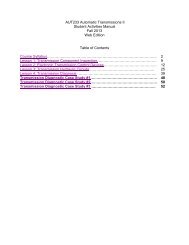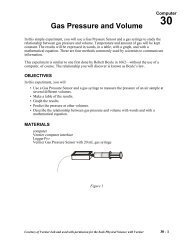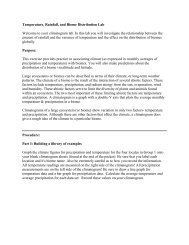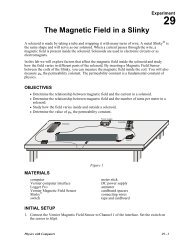Meteorology Lab Exercise: 5-Day Weather Log and Weather Patterns
Meteorology Lab Exercise: 5-Day Weather Log and Weather Patterns
Meteorology Lab Exercise: 5-Day Weather Log and Weather Patterns
You also want an ePaper? Increase the reach of your titles
YUMPU automatically turns print PDFs into web optimized ePapers that Google loves.
<strong>Meteorology</strong> <strong>Lab</strong> <strong>Exercise</strong>: 5-<strong>Day</strong> <strong>Weather</strong> <strong>Log</strong> <strong>and</strong><br />
<strong>Weather</strong> <strong>Patterns</strong><br />
Purpose: To record weather observation over a 5 day period <strong>and</strong> note the<br />
movement of weather patterns.<br />
Equipment: Internet Access<br />
Procedure: Using the Internet find a weather site that has up to the minute<br />
weather data for where you live. The weather site should have a surface<br />
forecast map that shows weather fronts <strong>and</strong> precipitation information. Five<br />
the next five day record the following information three times a day:<br />
Temperature, Wind Direction <strong>and</strong> Speed, Relative Humidity, Dew Point,<br />
Barometric Pressure, Cloud Cover. Make sure your daily reading are at least<br />
6 hours apart. Record these reading on the daily data sheet.
Print a weather map like the one below each time you gather reading from<br />
the internet. Clear highlight or mark the fronts <strong>and</strong> storm system on the<br />
map. Paste the maps into your daily record. Keep this record over the next<br />
five days. Then answer the questions at the end of the worksheet.
<strong>Day</strong> 1 2 3 4 5<br />
Date<br />
Early Morning Afternoon Night<br />
Temperature<br />
Wind Direction<br />
Wind Speed<br />
Relative Humidity<br />
Dew Point<br />
Barometric Pressure<br />
Precipitation<br />
Cloud Cover<br />
Paste Maps Here
<strong>Day</strong> 1 2 3 4 5<br />
Date<br />
Early Morning Afternoon Night<br />
Temperature<br />
Wind Direction<br />
Wind Speed<br />
Relative Humidity<br />
Dew Point<br />
Barometric Pressure<br />
Precipitation<br />
Cloud Cover<br />
Paste Maps Here
<strong>Day</strong> 1 2 3 4 5<br />
Date<br />
Early Morning Afternoon Night<br />
Temperature<br />
Wind Direction<br />
Wind Speed<br />
Relative Humidity<br />
Dew Point<br />
Barometric Pressure<br />
Precipitation<br />
Cloud Cover<br />
Paste Maps Here
<strong>Day</strong> 1 2 3 4 5<br />
Date<br />
Early Morning Afternoon Night<br />
Temperature<br />
Wind Direction<br />
Wind Speed<br />
Relative Humidity<br />
Dew Point<br />
Barometric Pressure<br />
Precipitation<br />
Cloud Cover<br />
Paste Maps Here
<strong>Day</strong> 1 2 3 4 5<br />
Date<br />
Early Morning Afternoon Night<br />
Temperature<br />
Wind Direction<br />
Wind Speed<br />
Relative Humidity<br />
Dew Point<br />
Barometric Pressure<br />
Precipitation<br />
Cloud Cover<br />
Paste Maps Here
Questions:<br />
1. Were you aware of the change in temperature when a cold or warm<br />
front passed through?<br />
2. When did the most clouds occur, during high pressure or low<br />
pressure? Can you explain why this is true?<br />
3. What direction did most of the fronts move?<br />
4. Did you notice the changes in the relative humidity from morning to<br />
evening? Explain.<br />
5. How did the wind direction change throughout the day as a high<br />
pressure or low pressure system moved through the area?<br />
6. How did the movement of fronts affect wind speed?


